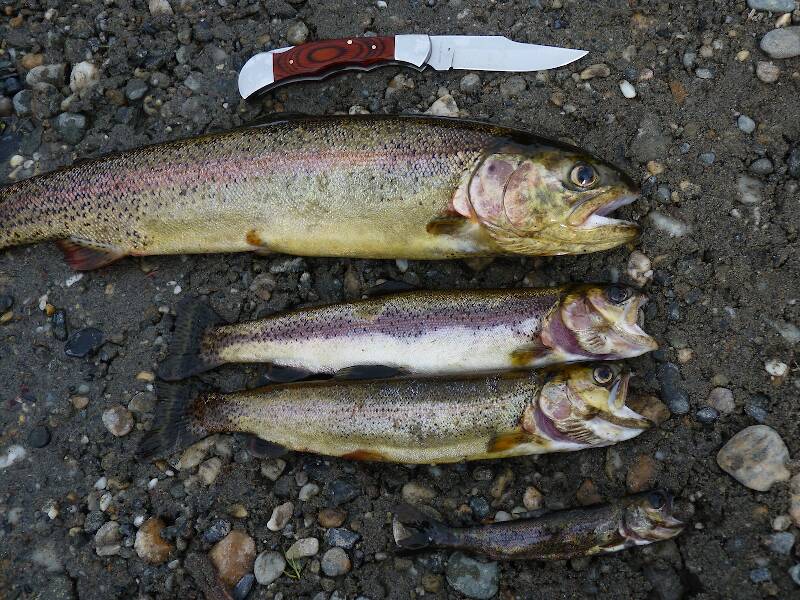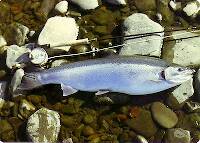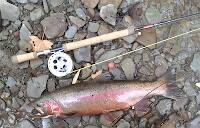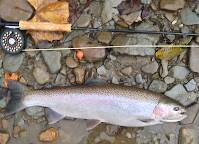
Hex Mayflies
Hexagenia limbata
The famous nocturnal Hex hatch of the Midwest (and a few other lucky locations) stirs to the surface mythically large brown trout that only touch streamers for the rest of the year.
Featured on the forum


Troutnut is a project started in 2003 by salmonid ecologist Jason "Troutnut" Neuswanger to help anglers and
fly tyers unabashedly embrace the entomological side of the sport. Learn more about Troutnut or
support the project for an enhanced experience here.
GldstrmSam on Nov 24, 2012November 24th, 2012, 11:57 am EST
I finally got a salmon fly rod!
Black Friday shopping is TOTALLY different up here than down in the lower 48. At least the temperatures you have to wait in are.:)
I waited for about 4 hrs in -16 Fahrenheit. The only way to survive up here doing that is to wear: 5 parkas, two pairs of Bunnie boots,beaver mittens...Well not quite. The best way to do it (the way I and many others did) is to bring a couple of other people, get in line and wait for enough people to get in line, then wait long enough so that they recognize you. Then they won't be mad when you come back from you turn to warm up in the car.:)
Any way the wait payed of after getting a FREE 50$ gift card from Big Ray's (a local sporting goods store) After that I went to Sportsman's Warehouse and got a TFO 8wt 9ft 4pc Pro Special rod for 70$. It was originally 149.99.
Since I now have a rod I am back to the fly reel question... As far as I can see Big Ray's only sells Sage fly reels. Since I have a gift card for there that is possibly where I will buy the reel. I would like to know what your opinions of Sage reels are.
Thanks
Sam
Black Friday shopping is TOTALLY different up here than down in the lower 48. At least the temperatures you have to wait in are.:)
I waited for about 4 hrs in -16 Fahrenheit. The only way to survive up here doing that is to wear: 5 parkas, two pairs of Bunnie boots,beaver mittens...Well not quite. The best way to do it (the way I and many others did) is to bring a couple of other people, get in line and wait for enough people to get in line, then wait long enough so that they recognize you. Then they won't be mad when you come back from you turn to warm up in the car.:)
Any way the wait payed of after getting a FREE 50$ gift card from Big Ray's (a local sporting goods store) After that I went to Sportsman's Warehouse and got a TFO 8wt 9ft 4pc Pro Special rod for 70$. It was originally 149.99.
Since I now have a rod I am back to the fly reel question... As far as I can see Big Ray's only sells Sage fly reels. Since I have a gift card for there that is possibly where I will buy the reel. I would like to know what your opinions of Sage reels are.
Thanks
Sam
There is no greater fan of fly fishing than the worm. ~Patrick F. McManus
DUBBN on Nov 24, 2012November 24th, 2012, 12:40 pm EST
Sage fly reels are great, awesome, superb. If thats all you can buy. :-)
Sorry, I could not resist. I have never bought/used a Sage reel so I really have no idea.
Sorry, I could not resist. I have never bought/used a Sage reel so I really have no idea.
It's OK to disagree with me. I can not force you to be right.
GldstrmSam on Nov 24, 2012November 24th, 2012, 1:18 pm EST
Thanks Dubbn :) :)
There is no greater fan of fly fishing than the worm. ~Patrick F. McManus
Pryal74 on Nov 26, 2012November 26th, 2012, 3:59 pm EST
Sage reels are phenomenal. I only use their products. Lifetime warranty as well. You can't go wrong with them, and I doubt you will be disappointed.
-James Pryal
Into The Wild Fly Fishing
Into The Wild Fly Fishing
Wbranch on Nov 29, 2012November 29th, 2012, 4:32 am EST
Today there are literally dozens of first class fly reels on the market. There was a time, back in the olden days LOL, where there were very few reel manufacturers. I remember only about three; the venerable Plueger Medalist series, the Hardy Lightweight reels, and some Martin reels. Today you can opt for old school pawl and gear click type drags or choose state of the art disc drags with low start up inertia.
Knowing you live in Alaska and there is a strong potential you could hook a fish that can really run and take line I'd recommend getting a reel with a good disc drag and a large arbor design capable of holding at least 50, if not 100, yards of backing. That being said I'm very partial to the Lamson Litespeed series of reels. I own a #1.5 that I use for all my big trout rivers and I use a #2 for my steelhead fishing where fish can reach 10# and more and run lots of line.
For fishing where I don't expect monsters I still like to use my Hardy LRH or Princess reels or an Abel Creek. Even big trout aren't normally going to run much more than your fly line and maybe of 50' of backing unless you hook him in really fast water where they get in the current and take off down river.
Cabela's sells some really nice fly reels under their own logo and there are probably a dozen other reel makers that offer good reels for no more than $150.00. But of course you can still get a very servicable fly reel for less than $100 but it is likely not going to be as esthetically attractive as a reel costing more.
Knowing you live in Alaska and there is a strong potential you could hook a fish that can really run and take line I'd recommend getting a reel with a good disc drag and a large arbor design capable of holding at least 50, if not 100, yards of backing. That being said I'm very partial to the Lamson Litespeed series of reels. I own a #1.5 that I use for all my big trout rivers and I use a #2 for my steelhead fishing where fish can reach 10# and more and run lots of line.
For fishing where I don't expect monsters I still like to use my Hardy LRH or Princess reels or an Abel Creek. Even big trout aren't normally going to run much more than your fly line and maybe of 50' of backing unless you hook him in really fast water where they get in the current and take off down river.
Cabela's sells some really nice fly reels under their own logo and there are probably a dozen other reel makers that offer good reels for no more than $150.00. But of course you can still get a very servicable fly reel for less than $100 but it is likely not going to be as esthetically attractive as a reel costing more.
Catskill fly fisher for fifty-five years.
Entoman on Nov 29, 2012November 29th, 2012, 8:41 am EST
I have nothing to add to the great comments other than to say stay away from disk drags that aren't sealed! Ice crystals can form on the drag surfaces causing them to spit line. Not a good thing...:)
"It's not that I find fishing so important, it's just that I find all other endeavors of Man equally unimportant... And not nearly as much fun!" Robert Traver, Anatomy of a Fisherman
Gutcutter on Dec 1, 2012December 1st, 2012, 4:31 am EST
...stay away from disk drags that aren't sealed! Ice crystals can form on the drag surfaces causing them to spit line. Not a good thing...
I don't understand that comment, Kurt. How can a cork or rulon disc drag spit line? Maybe I don't understand what you mean by "spit line"
Some of the best big game reels have non-sealed or exposed drags.
I own Tibor, Islander and Abel big game and trout/salmon reels that work well in all conditions - from hot tropical flats fishing to cold Alaskan salmon and rainbow fishing to frozen Great Lakes steelhead fishing.
I also own Lamson and Galvan big game and trout/salmon sealed drag reels.
There really is an advantage with the open cork and rulon drags as far as pure stopping power.
The sealed drags are lighter and have a little more "smoothness" when the line first comes off of the reel, but those are really their only advantages.
A major disadvantage is the amount of abuse they can take. The best machined reels with spools that have very minute gap tolerances fail with a moderate amount of dirt or sand in them. A drop on rocks (or in one case a parking lot) will bend the light frame and provide a nice grinding noise for you to enjoy. Oh, and the manufactures (including Sage) don't honor abuse in their warranties.
They are all beautiful and function well. And none of them are inexpensive.
But, you get what you pay for...
All men who fish may in turn be divided into two parts: those who fish for trout and those who don't. Trout fishermen are a race apart: they are a dedicated crew- indolent, improvident, and quietly mad.
-Robert Traver, Trout Madness
-Robert Traver, Trout Madness
Entoman on Dec 2, 2012December 2nd, 2012, 1:55 am EST
Ah! Good points Tony, as usual. If Sam is going to use his "salmon rod' to fight big kings in estuaries or lower in the big rivers during reasonably temperate conditions (which is certainly common in AK), my comments may be a bit off the mark. I was thinking of those days when the rod guides can ice up.
By "spitting line" I mean the drag suddenly skating on ice crystals for a number of rotations before catching again as the crystals melted, I assume to friction heat finally kicking in. Once had a nice steelhead in BC of probably 15 lbs. or so bolt on the strike when this phenomenon caused an immediate bird's nest. Goodbye fish... I remember fishing a Maine lake one early morning at "ice out" when a big togue did the same thing on a different reel of similar design. Even stripping out line to prepare for a cast can cause a bird's nest. There have been countless other examples that happened to me before I wised up. It feels very strange when it happens and at first I thought it was just an internal design fault unrelated to the weather (slow learner). Now based on event per angler hour it is admittedly a very rare occurrence with most designs, but it does happen, either from a dunking or the repetitive wet line going on and off the reel as is pretty frequent when steelheading using conventional fly tackle. Even so, with the potential of a fish of a lifetime out there, why take the chance? By comparison though, the older Lamsons with the caliper type exposed disk drags were virtually unusable in freezing conditions.
A few of the reels you listed are some of the finest ever made and a "reel" improvement over the old Seamasters and Fin-Nors of old (at least in terms of weight and line retrieval if not quality) and perform flawlessly in above freezing conditions provided you keep them clean & maintained according to manufacturer's suggestions. Porche performance, Abrams tank power! I also agree with you about the stopping power of exposed drags, though in theory the conical design is supposed to counter the problem of reduced drag surface (a weakness inherent in most internal systems). Besides the unfortunate experience of exposed drags (even of the highest quality) failing me at times in the kinds of conditions he'll often run into if he fishes early or late in the season, I have not found stopping power to be all that important in a freshwater reel and never advise fishing with a cranked down drag or messing with it during a fight. A moderate to light setting that relies on rod angle and other measures to control pressure are what I recommend. However, the ability to handle sudden high RPM's is certainly an important feature. I have a few large classic Hardys that have never failed me, and they have accounted for many large steelhead & salmon over the years, but I've heard enough horror stories about pawls flying loose under speed that I must admit to feeling more confident with a good modern sealed disk drag reel. Being old school though, I have to admit I miss that good old Hardy scream when a big fish runs...:)
My current favorite big freshwater reels are in the original Loop Evotec IW series. I have a brace of them that perform as well as they look and their construction quality is like a fine Swiss watch. What they lack in ownership status by comparison to Bogdans and other similar freshwater designs is more than made up for by their light weight and line retrieval speed when you have a nice fish several hundred feet out. They were expensive when I acquired them but even so, my understanding is they were losing money so the series was discontinued and then reintroduced with a modified design and cheaper methods. I'm not even sure they're still made in Sweden anymore.
Another point about reel performance... Smoothness and startup inertia are two (one?) giant myth(s) in terms of their importance, while consistency (which is very important) is rarely if ever mentioned in the marketing. First off, if different from "start up", what is smoothness? The difference between a disk vs. a click & pawl's vibration transferred to the rod hand? That is some pretty subtle crap, especially with a fish on the line swimming away from you you at 20 MPH! Ooh! I feel a subtle increase in vibration! Who's thinking about that at the time? Besides, differences in "start up" between reels of decent quality is of very marginal importance for 7X tippets and no importance for larger, IMO. I've caught thousands of light tippet spring creek fish on my Hardy LRH over the last 35+ years and can honestly say I've never lost a fish that I remember over "start up." What is important is consistency. By comparison the disk drive trout models I own (Bauer, Galvan, Lamson, Ross, Teton and a few others that don't come to mind at this time), are very inconsistent by comparison. It seems I'm constantly fiddling with their knobs to keep them "in the zone" during a fishing session. By comparison, the LRH has had its springs tweaked a little and it's set wide open and I haven't touched its setting in years! Heck, for all I know the little compensator knob is frozen in position.:)
It's funny I guess, but for example when I'm on Fall River I'll usually have 3 or 4 of the latest setups rigged up but when I come across a particularly difficult or large fish sipping little stuff, I'll often go for the old San Francisco made Scott 9-4 with the little Hardy on it. Maybe it's like the relationship one has with a favorite shotgun? It may not be the latest and greatest, but man can I shoot with it!:)
By "spitting line" I mean the drag suddenly skating on ice crystals for a number of rotations before catching again as the crystals melted, I assume to friction heat finally kicking in. Once had a nice steelhead in BC of probably 15 lbs. or so bolt on the strike when this phenomenon caused an immediate bird's nest. Goodbye fish... I remember fishing a Maine lake one early morning at "ice out" when a big togue did the same thing on a different reel of similar design. Even stripping out line to prepare for a cast can cause a bird's nest. There have been countless other examples that happened to me before I wised up. It feels very strange when it happens and at first I thought it was just an internal design fault unrelated to the weather (slow learner). Now based on event per angler hour it is admittedly a very rare occurrence with most designs, but it does happen, either from a dunking or the repetitive wet line going on and off the reel as is pretty frequent when steelheading using conventional fly tackle. Even so, with the potential of a fish of a lifetime out there, why take the chance? By comparison though, the older Lamsons with the caliper type exposed disk drags were virtually unusable in freezing conditions.
A few of the reels you listed are some of the finest ever made and a "reel" improvement over the old Seamasters and Fin-Nors of old (at least in terms of weight and line retrieval if not quality) and perform flawlessly in above freezing conditions provided you keep them clean & maintained according to manufacturer's suggestions. Porche performance, Abrams tank power! I also agree with you about the stopping power of exposed drags, though in theory the conical design is supposed to counter the problem of reduced drag surface (a weakness inherent in most internal systems). Besides the unfortunate experience of exposed drags (even of the highest quality) failing me at times in the kinds of conditions he'll often run into if he fishes early or late in the season, I have not found stopping power to be all that important in a freshwater reel and never advise fishing with a cranked down drag or messing with it during a fight. A moderate to light setting that relies on rod angle and other measures to control pressure are what I recommend. However, the ability to handle sudden high RPM's is certainly an important feature. I have a few large classic Hardys that have never failed me, and they have accounted for many large steelhead & salmon over the years, but I've heard enough horror stories about pawls flying loose under speed that I must admit to feeling more confident with a good modern sealed disk drag reel. Being old school though, I have to admit I miss that good old Hardy scream when a big fish runs...:)
My current favorite big freshwater reels are in the original Loop Evotec IW series. I have a brace of them that perform as well as they look and their construction quality is like a fine Swiss watch. What they lack in ownership status by comparison to Bogdans and other similar freshwater designs is more than made up for by their light weight and line retrieval speed when you have a nice fish several hundred feet out. They were expensive when I acquired them but even so, my understanding is they were losing money so the series was discontinued and then reintroduced with a modified design and cheaper methods. I'm not even sure they're still made in Sweden anymore.
Another point about reel performance... Smoothness and startup inertia are two (one?) giant myth(s) in terms of their importance, while consistency (which is very important) is rarely if ever mentioned in the marketing. First off, if different from "start up", what is smoothness? The difference between a disk vs. a click & pawl's vibration transferred to the rod hand? That is some pretty subtle crap, especially with a fish on the line swimming away from you you at 20 MPH! Ooh! I feel a subtle increase in vibration! Who's thinking about that at the time? Besides, differences in "start up" between reels of decent quality is of very marginal importance for 7X tippets and no importance for larger, IMO. I've caught thousands of light tippet spring creek fish on my Hardy LRH over the last 35+ years and can honestly say I've never lost a fish that I remember over "start up." What is important is consistency. By comparison the disk drive trout models I own (Bauer, Galvan, Lamson, Ross, Teton and a few others that don't come to mind at this time), are very inconsistent by comparison. It seems I'm constantly fiddling with their knobs to keep them "in the zone" during a fishing session. By comparison, the LRH has had its springs tweaked a little and it's set wide open and I haven't touched its setting in years! Heck, for all I know the little compensator knob is frozen in position.:)
It's funny I guess, but for example when I'm on Fall River I'll usually have 3 or 4 of the latest setups rigged up but when I come across a particularly difficult or large fish sipping little stuff, I'll often go for the old San Francisco made Scott 9-4 with the little Hardy on it. Maybe it's like the relationship one has with a favorite shotgun? It may not be the latest and greatest, but man can I shoot with it!:)
"It's not that I find fishing so important, it's just that I find all other endeavors of Man equally unimportant... And not nearly as much fun!" Robert Traver, Anatomy of a Fisherman
GldstrmSam on Dec 2, 2012December 2nd, 2012, 7:29 pm EST
Whether you posted a couple sentences or an essay (Entoman:) thank you for all the help.
I will likely go for one of those Sage reels. 1st because that lifetime warranty looks very appealing. 2nd because at this time that is what most if not all the reels are that are sold at Big Ray's (the store I have a 50$ gift card for)
Sam
I will likely go for one of those Sage reels. 1st because that lifetime warranty looks very appealing. 2nd because at this time that is what most if not all the reels are that are sold at Big Ray's (the store I have a 50$ gift card for)
Sam
There is no greater fan of fly fishing than the worm. ~Patrick F. McManus
Crepuscular on Dec 3, 2012December 3rd, 2012, 6:12 am EST
I'm not familiar with the current Sage drag systems, but what I can say is that the somewhat older Sage reels that I have (3000D Series), the drag system, I believe, was designed by Jack Charlton, are pretty amazing, I have a few of them in both fresh and saltwater sizes. No issues ever, from trout to tarpon.They do not seem as sturdy as my Tibors, Abels, and Pate reels but like I said I've had no issues. And I'm not the best at taking care of my tackle. I tend to wash them off and loosen the drag and that's pretty much it.
Falsifly on Dec 3, 2012December 3rd, 2012, 10:01 am EST
The discussion started asking for an opinion on Sage reels for salmon, and quickly shifted to drag systems. Then “start-up” and 7X tippet was brought up in the discussion, but not one mention of palming. ALL my trout fishing is done with the drag set at the minimum, just enough to prevent over-spooling, and pressure is applied with rod angle while drag is applied with instantly variable palm pressure. Years ago I received a big name reel as a gift; it was a small framed light reel with a sealed disc drag. The midge fishing was demanding at #28’s and 8X and with the drag set to the low stop it was still too tight, resulting in break offs. I managed to disassemble the drag and lessen the load, but that created another problem which caused the drag setting to wander on its own. After that trip I contacted the manufacturer who promptly corrected the problem at no charge. Now I set it once and never touch it again, regardless of the tippet size in use. I won’t weigh in on salmon reels but as far as I’m concerned expensive drag systems are a waste of money to me.
Falsifly
When asked what I just caught that monster on I showed him. He put on his magnifiers and said, "I can't believe they can see that."
When asked what I just caught that monster on I showed him. He put on his magnifiers and said, "I can't believe they can see that."
Entoman on Dec 3, 2012December 3rd, 2012, 2:46 pm EST
Eric -
Yeah, I'm pretty much that way too. On your reels with exposed cork/rulon systems though you do need to periodically clean them and make sure the cork isn't "dried out." A VERY light coat of a fine reel oil should always be on the cork surface after making sure that no foreign matter is in there. At the other end of the spectrum, over oiling can lead to cork rot and if the reel is left lying around for some time, some oils can almost turn into a varnish like substance. In my fly shop days I saw more than one of these drag systems come into the shop seized up for lack of proper maintenance.
PS - the only maintenance really required on an internal system or the traditional click & pawl is a an occasional light coat of oil on the spindles to keep them rotating smoothly.
Al -
Thanks for bringing up this very good point. I alluded to it in my mention of "other measures to control pressure" but felt my "blog" was long enough already and couldn't take further embellishment:) Personally, I think palming is not a good term to use regarding this technique for freshwater use (especially with tiny tippets) as it can mislead the neophyte. I prefer "feathering the spool". I use my fingers, and contrary to angler myth, you don't need an exposed rim to use the method properly. I'd sure like to hear Tony's and other's input regarding this technique when battling the big saltwater denizens.
Exactly! My only comment here is that I have yet to use an internal drag system that permanently stays at this subtle setting anywhere near as consistently as a quality click & pawl system. It seems I'm always fiddling with them during the day. Any of you fortunate to own one of the older Hardy LRH's - the compensator needs to be all the way open and the springs need to be squeezed a little with fine nosed pliers to lighten them enough for this setting as most came from the factory a little to firm. When the springs are right, the reels purr like kittens!
To my way of thinking modern reels (for trout) have only three features that I would consider vast improvements - metalurgy, finish coatings & large arbor design. The former allows lighter and stronger reels of any design and the latter offers much faster line retrieval and more consistent pressure on the fish, regardless how much line is out. Traditional designs really pick up the RPM's for a given length of line-out as you get into the backing (exponentially so, if you get too deep).
The irony is that saltwater "bells and whistles" like counter weights and bulky disk drags have been unnecessarily incorporated into trout reels at the expense of ruggedness to keep them remotely in the same category weight wise. The only "real" support of the spool on most of these models is the spindle. If that gets knocked out of true, it's the dickens fixing it. Much easier to fix a bent portion of the outside frame.
My idea of a perfect trout reel design? Take the LRH, machine it from modern alloys, port the back, give it one of the modern surface hardening finishes, widen and shallow up the spool, drop the nickle silver line guard (made redundant by new alloys and finishes), drop the compensator check and tune the springs for proper tension... It would be the lightest, best performing, and most durable reel on the market for a given line capacity.
BTW - the old exposed rim Hardys that were sold under the S.A. label are crap. You know, the ones with the plastic spindle hubs? That is NOT the tried and true Hardy LRH click and pawl system but rather an embarrassing Mickey Mouse design. The sprockets have so few teeth that the start up is unfixably sticky and when line is underway a boat trailer winch ratchet is smoother. The sound is "nails on a chalkboard"... And the exposed rims? They were so thin and soft that they'd dent by looking at them too hard... Cheap finish as well. The irony is that when the exposed rim craze started, demand (and 3M's marketing clout) allowed that junk to sell for as much as the LRH's at the peak of their popularity.
One last comment... I wish the reel manufacturers would go to a rivet system for attaching the reel foot. Set screws don't cut it as some of the bodies are too thin. Steel embedded in a few threads of aluminum is not a good solution. I've fallen on a Hardy so hard in the rocks that the frame cracked and the rod's reel seat was bent and ruined without the foot coming loose. The Hardy system has never failed me or anyone I know. I have had feet come off set screw designs. One expensive reel plopped into the river awhile back while reeling against the tension of a nice fish. The screws had not come loose, they stripped the aluminum threads of the reel body.
Sorry for the blog guys, but I was "on a roll out of control"!:)
And I'm not the best at taking care of my tackle. I tend to wash them off and loosen the drag and that's pretty much it.
Yeah, I'm pretty much that way too. On your reels with exposed cork/rulon systems though you do need to periodically clean them and make sure the cork isn't "dried out." A VERY light coat of a fine reel oil should always be on the cork surface after making sure that no foreign matter is in there. At the other end of the spectrum, over oiling can lead to cork rot and if the reel is left lying around for some time, some oils can almost turn into a varnish like substance. In my fly shop days I saw more than one of these drag systems come into the shop seized up for lack of proper maintenance.
PS - the only maintenance really required on an internal system or the traditional click & pawl is a an occasional light coat of oil on the spindles to keep them rotating smoothly.
Al -
Then “start-up” and 7X tippet was brought up in the discussion, but not one mention of palming.
Thanks for bringing up this very good point. I alluded to it in my mention of "other measures to control pressure" but felt my "blog" was long enough already and couldn't take further embellishment:) Personally, I think palming is not a good term to use regarding this technique for freshwater use (especially with tiny tippets) as it can mislead the neophyte. I prefer "feathering the spool". I use my fingers, and contrary to angler myth, you don't need an exposed rim to use the method properly. I'd sure like to hear Tony's and other's input regarding this technique when battling the big saltwater denizens.
ALL my trout fishing is done with the drag set at the minimum, just enough to prevent over-spooling.
Exactly! My only comment here is that I have yet to use an internal drag system that permanently stays at this subtle setting anywhere near as consistently as a quality click & pawl system. It seems I'm always fiddling with them during the day. Any of you fortunate to own one of the older Hardy LRH's - the compensator needs to be all the way open and the springs need to be squeezed a little with fine nosed pliers to lighten them enough for this setting as most came from the factory a little to firm. When the springs are right, the reels purr like kittens!
To my way of thinking modern reels (for trout) have only three features that I would consider vast improvements - metalurgy, finish coatings & large arbor design. The former allows lighter and stronger reels of any design and the latter offers much faster line retrieval and more consistent pressure on the fish, regardless how much line is out. Traditional designs really pick up the RPM's for a given length of line-out as you get into the backing (exponentially so, if you get too deep).
The irony is that saltwater "bells and whistles" like counter weights and bulky disk drags have been unnecessarily incorporated into trout reels at the expense of ruggedness to keep them remotely in the same category weight wise. The only "real" support of the spool on most of these models is the spindle. If that gets knocked out of true, it's the dickens fixing it. Much easier to fix a bent portion of the outside frame.
My idea of a perfect trout reel design? Take the LRH, machine it from modern alloys, port the back, give it one of the modern surface hardening finishes, widen and shallow up the spool, drop the nickle silver line guard (made redundant by new alloys and finishes), drop the compensator check and tune the springs for proper tension... It would be the lightest, best performing, and most durable reel on the market for a given line capacity.
BTW - the old exposed rim Hardys that were sold under the S.A. label are crap. You know, the ones with the plastic spindle hubs? That is NOT the tried and true Hardy LRH click and pawl system but rather an embarrassing Mickey Mouse design. The sprockets have so few teeth that the start up is unfixably sticky and when line is underway a boat trailer winch ratchet is smoother. The sound is "nails on a chalkboard"... And the exposed rims? They were so thin and soft that they'd dent by looking at them too hard... Cheap finish as well. The irony is that when the exposed rim craze started, demand (and 3M's marketing clout) allowed that junk to sell for as much as the LRH's at the peak of their popularity.
One last comment... I wish the reel manufacturers would go to a rivet system for attaching the reel foot. Set screws don't cut it as some of the bodies are too thin. Steel embedded in a few threads of aluminum is not a good solution. I've fallen on a Hardy so hard in the rocks that the frame cracked and the rod's reel seat was bent and ruined without the foot coming loose. The Hardy system has never failed me or anyone I know. I have had feet come off set screw designs. One expensive reel plopped into the river awhile back while reeling against the tension of a nice fish. The screws had not come loose, they stripped the aluminum threads of the reel body.
Sorry for the blog guys, but I was "on a roll out of control"!:)
"It's not that I find fishing so important, it's just that I find all other endeavors of Man equally unimportant... And not nearly as much fun!" Robert Traver, Anatomy of a Fisherman
Falsifly on Dec 3, 2012December 3rd, 2012, 3:24 pm EST
Sorry for the blog guys, but I was "on a roll out of control"!:)
Lighten up on yourself Kurt, We'll let you know when reading you blog becomes a reel drag :)
Falsifly
When asked what I just caught that monster on I showed him. He put on his magnifiers and said, "I can't believe they can see that."
When asked what I just caught that monster on I showed him. He put on his magnifiers and said, "I can't believe they can see that."
Crepuscular on Dec 3, 2012December 3rd, 2012, 3:58 pm EST
As usual I understated my maintenance ritual, I do do add a light coat of oil to keep the cork from drying out.
I'm sure Tony has more big fish fighting experience than me but "palming" a reel when you are attached to a really powerful fish like a tuna or tarpon can be a little scary. But that said there are times when I have felt that its time to really "turn the screws" to a fish when it's close to the boat if I think my connections are up to it. When that time comes I have clamped down on the spool and turned the fish especially if you have the fish in the last portion of the fight and need to lift them. I would imagine that Tony's fingers are more important to him than mine are to me though, I wonder if he does this as well?
I'd sure like to hear Tony's and other's input regarding this technique when battling the big saltwater denizens.
I'm sure Tony has more big fish fighting experience than me but "palming" a reel when you are attached to a really powerful fish like a tuna or tarpon can be a little scary. But that said there are times when I have felt that its time to really "turn the screws" to a fish when it's close to the boat if I think my connections are up to it. When that time comes I have clamped down on the spool and turned the fish especially if you have the fish in the last portion of the fight and need to lift them. I would imagine that Tony's fingers are more important to him than mine are to me though, I wonder if he does this as well?
Gutcutter on Dec 4, 2012December 4th, 2012, 6:15 am EST
My idea of a perfect trout reel design? Take the LRH, machine it from modern alloys, port the back, give it one of the modern surface hardening finishes, widen and shallow up the spool, drop the nickle silver line guard (made redundant by new alloys and finishes), drop the compensator check and tune the springs for proper tension... It would be the lightest, best performing, and most durable reel on the market for a given line capacity.
If that is your description, then here is your "perfect" reel: Islander - IR3LA
http://www.islander.com/products.php?prdRef=ir3la.xml&specs=false&lbm=true&lblw=false
The music is a bit more baritone than the LHR, but sweet nonetheless.
I prefer the non large arbor IR reels and even have one on my favorite cane rod (is that a sin?) From my cold, dead hands...
As far as "palming the reel" on big game - don't do it. Easier said than done. I received another set of bloody knuckles this year for not heeding my own advice.
I try to clamp the fly line under the palm of my rod hand while I'm really giving the fish the "down n dirty", but sometimes in the heat of a spirited fight, I get stung. It usually happens on the first day of the trip, and not again for another year...
I agree with Allan and Kurt on drag settings for trout and light tippet.
Drag settings and fighting big game fish is a topic for another day.
All men who fish may in turn be divided into two parts: those who fish for trout and those who don't. Trout fishermen are a race apart: they are a dedicated crew- indolent, improvident, and quietly mad.
-Robert Traver, Trout Madness
-Robert Traver, Trout Madness
Entoman on Dec 4, 2012December 4th, 2012, 11:43 pm EST
If that is your description, then here is your "perfect" reel: Islander - IR3LA.
As you would notice, the "guts" are right.:) The design is close to what was envisioned except I'm thinking of a reel a little less "industrial strength" looking and with a darker gunmetal finish that would look great on a bamboo rod. The Islander also still incorporates a half frame so that the saltwater popular (but unnecessary and I would argue counter-productive) big handle and counter weight I mentioned earlier can be added for roughly the same total weight...
Thanks for the input about palming, makes a lot of sense.
"It's not that I find fishing so important, it's just that I find all other endeavors of Man equally unimportant... And not nearly as much fun!" Robert Traver, Anatomy of a Fisherman
Feathers5
Posts: 287
Posts: 287
Feathers5 on Dec 5, 2012December 5th, 2012, 3:48 am EST
I didn't have time to read all of these posts, but Tony and Entoman, is the Islander Reel a click and pawl? I'd sure like to buy one for a 5 or 6 wt. rod. I bought the L. L. Bean Pocket Water Fly Reel for $79 last year and I really love the thing. I use it on my 3/4 wt. rods. It has a great start up that protects tippets and is a solid reel. I don't work for them, but for $79, it's an option for those on a tight budget. Of course, if I had the money right now, I'd buy an Islander. I had Tony's Islander in my hands. What a great reel. I tried to steal it, but he kept his eye on me.
Bruce
http://www.llbean.com/llb/shop/72813?feat=fly fishing-SR2&page=pocket-water-fly-reel&attrValue_0=Gray&productId=1201787
Bruce
http://www.llbean.com/llb/shop/72813?feat=fly fishing-SR2&page=pocket-water-fly-reel&attrValue_0=Gray&productId=1201787
Entoman on Dec 5, 2012December 5th, 2012, 9:37 am EST
Bruce -
As to your question about the Islander, yes.
BTW - I agree about L.L. Bean reels... There are others as well that are very servicable in the affordable class. I see no reason to ever recommend reels like the Martins and Pfluegers of old. They are heavy, clunky, cheaply constructed pot metal designs and their drag systems are horrible.
As to your question about the Islander, yes.
BTW - I agree about L.L. Bean reels... There are others as well that are very servicable in the affordable class. I see no reason to ever recommend reels like the Martins and Pfluegers of old. They are heavy, clunky, cheaply constructed pot metal designs and their drag systems are horrible.
"It's not that I find fishing so important, it's just that I find all other endeavors of Man equally unimportant... And not nearly as much fun!" Robert Traver, Anatomy of a Fisherman
GldstrmSam on Dec 8, 2012December 8th, 2012, 3:19 pm EST
Thanks again for all of your help!
Since money doesn't grow on trees as my dad used to say what is the least expensive Sage reel that you recommend?
This question is mostly directed to James, but if anybody else has recommendation that would be great. I don't want to spend over 120$ on a reel, but if I have to I might be willing to spend up to 150$. Is that reasonable?
Since money doesn't grow on trees as my dad used to say what is the least expensive Sage reel that you recommend?
This question is mostly directed to James, but if anybody else has recommendation that would be great. I don't want to spend over 120$ on a reel, but if I have to I might be willing to spend up to 150$. Is that reasonable?
There is no greater fan of fly fishing than the worm. ~Patrick F. McManus
Strmanglr on Dec 8, 2012December 8th, 2012
There's an old saying in the retail world u may or may not have heard, but think about it and how long u intend on owning this reel
“It's unwise to pay too much, but it's worse to pay too little. When you pay too much, you lose a little money - that's all. When you pay too little, you sometimes lose everything, because the thing you bought was incapable of doing the thing it was bought to do. The common law of business balance prohibits paying a little and getting a lot - it can't be done. If you deal with the lowest bidder, it is well to add something for the risk you run, and if you do that you will have enough to pay for something good.
― John Ruskin
“It's unwise to pay too much, but it's worse to pay too little. When you pay too much, you lose a little money - that's all. When you pay too little, you sometimes lose everything, because the thing you bought was incapable of doing the thing it was bought to do. The common law of business balance prohibits paying a little and getting a lot - it can't be done. If you deal with the lowest bidder, it is well to add something for the risk you run, and if you do that you will have enough to pay for something good.
― John Ruskin
Quick Reply
Related Discussions
Topic
Replies
Last Reply
1
Jun 24, 2013
by Sayfu
by Sayfu
1
Sep 7, 2015
by PaulRoberts
by PaulRoberts
2
Oct 19, 2015
by Wbranch
by Wbranch















